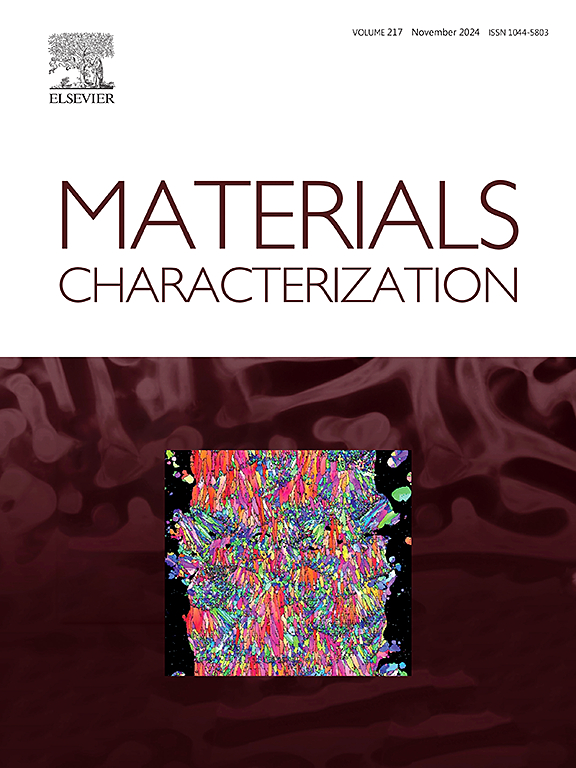Microstructure and mechanical properties of the Al2O3/Al joint bonded by Bi2O3-B2O3-SiO2-ZnO-Al2O3 + Al particles composite glass solder
IF 4.8
2区 材料科学
Q1 MATERIALS SCIENCE, CHARACTERIZATION & TESTING
引用次数: 0
Abstract
Glass solder with adjustable thermal expansion coefficient exhibits unique advantages in dissimilar material joining, yet its inherent brittleness remains a critical constraint hindering broader application potential. To solve this problem, micron-sized Al particles were added to glass to address the negative impact caused by the inherent brittleness of glass solder. In this study, the Bi2O3-B2O3-SiO2-ZnO-Al2O3 + Al particles composite solder was utilized to join 99Al2O3 ceramic and Al alloy 1060. Prior to the joining process, the surface morphology and thermophysical properties of the composite glass solder were investigated. Subsequently, the microstructure of the Al2O3/Al joints was analyzed in detail and mechanical properties of the joints were evaluated under different Al particle content. A peak value of 51.49 MPa was achieved at an Al particle content of 4 wt%, marking a 71.21 % increase compared to joints without Al particles. The precipitated phases in the glass solder are refined and their population is increased with elevated Al particle content, whereby the toughness of the bonding seam is enhanced, leading to improved mechanical properties of the joints. However, an excessive Al particle content results in increased porosity of the solder and deteriorated wettability, compromising the formation of joints and severely degrading the mechanical performance.
Bi2O3-B2O3-SiO2-ZnO-Al2O3 + Al颗粒复合玻璃焊料连接Al2O3/Al的显微组织和力学性能
热膨胀系数可调的玻璃焊料在异种材料连接中具有独特的优势,但其固有的脆性仍然是制约其广泛应用潜力的关键因素。为了解决这一问题,在玻璃中加入了微米级的Al颗粒,以解决玻璃焊料固有脆性带来的负面影响。本研究采用Bi2O3-B2O3-SiO2-ZnO-Al2O3 + Al颗粒复合钎料连接99Al2O3陶瓷和1060铝合金。在连接工艺之前,研究了复合玻璃焊料的表面形貌和热物理性能。随后,详细分析了Al2O3/Al接头的显微组织,并对不同Al颗粒含量下接头的力学性能进行了评价。当Al颗粒含量为4 wt%时,接头的峰值为51.49 MPa,比未添加Al颗粒时提高了71.21%。随着Al颗粒含量的增加,玻璃焊料中的析出相得到细化,析出相数量增加,从而增强了焊缝的韧性,从而改善了接头的力学性能。然而,过量的Al颗粒含量会导致焊料孔隙率增加,润湿性变差,影响接头的形成,严重降低机械性能。
本文章由计算机程序翻译,如有差异,请以英文原文为准。
求助全文
约1分钟内获得全文
求助全文
来源期刊

Materials Characterization
工程技术-材料科学:表征与测试
CiteScore
7.60
自引率
8.50%
发文量
746
审稿时长
36 days
期刊介绍:
Materials Characterization features original articles and state-of-the-art reviews on theoretical and practical aspects of the structure and behaviour of materials.
The Journal focuses on all characterization techniques, including all forms of microscopy (light, electron, acoustic, etc.,) and analysis (especially microanalysis and surface analytical techniques). Developments in both this wide range of techniques and their application to the quantification of the microstructure of materials are essential facets of the Journal.
The Journal provides the Materials Scientist/Engineer with up-to-date information on many types of materials with an underlying theme of explaining the behavior of materials using novel approaches. Materials covered by the journal include:
Metals & Alloys
Ceramics
Nanomaterials
Biomedical materials
Optical materials
Composites
Natural Materials.
 求助内容:
求助内容: 应助结果提醒方式:
应助结果提醒方式:


